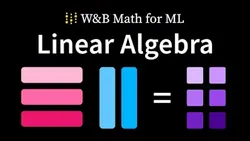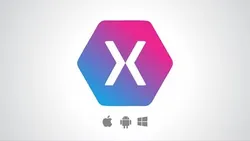
Math4ML Exercises: Linear Algebra contd 
This course covers the fundamentals of linear algebra and its application to machine learning. It introduces linear algebra as a programming language and provides exercises to help students understand the concepts. Exercises include shape-checking as type-checking, composing two and four matrices, and using matrix multiplication as a for loop. The course also provides an introduction to linear algebra libraries and how to use them. ▼
ADVERTISEMENT
Course Feature
![]() Cost:
Cost:
Free
![]() Provider:
Provider:
Youtube
![]() Certificate:
Certificate:
Paid Certification
![]() Language:
Language:
English
![]() Start Date:
Start Date:
On-Demand
Course Overview
❗The content presented here is sourced directly from Youtube platform. For comprehensive course details, including enrollment information, simply click on the 'Go to class' link on our website.
Updated in [February 21st, 2023]
Math4ML Exercises: Linear Algebra contd is a course designed to help students understand linear algebra as a programming language. The course begins with a teaser to introduce the concepts of linear algebra and its application in machine learning. It then moves on to an introduction to linear algebra as programming, followed by exercises such as shape-checking as type-checking, composing two matrices, composing four matrices, and matrix multiplication as a for loop. The course also covers topics such as matrices as batches of vectors, concatenating matrices as parallel programming, and making a repeater. Finally, the course concludes with an overview of the two views of matrices in machine learning.
[Applications]
After completing this course, students can apply the concepts of linear algebra to programming by using shape-checking as type-checking, composing two or four matrices, using matrix multiplication as a for loop, and concatenating matrices as parallel programming. Additionally, students can use the two views of matrices in ML to further their understanding of the subject.
[Career Paths]
1. Data Scientist: Data Scientists use mathematics, statistics, and machine learning to analyze data and develop insights. They use linear algebra to develop models and algorithms to solve problems. They also use linear algebra to create visualizations and interpret data. As data science continues to grow, the demand for data scientists with strong linear algebra skills will continue to increase.
2. Machine Learning Engineer: Machine Learning Engineers use linear algebra to develop and optimize machine learning algorithms. They use linear algebra to create models and algorithms that can be used to solve complex problems. As machine learning continues to become more popular, the demand for machine learning engineers with strong linear algebra skills will continue to increase.
3. Artificial Intelligence Engineer: Artificial Intelligence Engineers use linear algebra to develop and optimize artificial intelligence algorithms. They use linear algebra to create models and algorithms that can be used to solve complex problems. As artificial intelligence continues to become more popular, the demand for AI engineers with strong linear algebra skills will continue to increase.
4. Software Developer: Software Developers use linear algebra to develop software applications. They use linear algebra to create algorithms and models that can be used to solve complex problems. As software development continues to become more popular, the demand for software developers with strong linear algebra skills will continue to increase.
[Education Paths]
1. Bachelor of Science in Mathematics: This degree path focuses on the fundamentals of mathematics, including linear algebra, calculus, and statistics. It also covers topics such as probability, numerical analysis, and computer science. This degree is ideal for those interested in pursuing a career in data science, machine learning, or artificial intelligence. Developing trends in this field include the use of big data and the application of mathematical models to solve real-world problems.
2. Master of Science in Applied Mathematics: This degree path focuses on the application of mathematics to solve real-world problems. It covers topics such as numerical analysis, optimization, and machine learning. This degree is ideal for those interested in pursuing a career in data science, artificial intelligence, or software engineering. Developing trends in this field include the use of artificial intelligence and machine learning to solve complex problems.
3. Doctor of Philosophy in Mathematics: This degree path focuses on advanced topics in mathematics, such as algebra, analysis, and geometry. It also covers topics such as probability, numerical analysis, and computer science. This degree is ideal for those interested in pursuing a career in research or academia. Developing trends in this field include the use of mathematical models to solve real-world problems and the application of machine learning to solve complex problems.
4. Master of Science in Data Science: This degree path focuses on the application of data science to solve real-world problems. It covers topics such as data mining, machine learning, and artificial intelligence. This degree is ideal for those interested in pursuing a career in data science, artificial intelligence, or software engineering. Developing trends in this field include the use of big data and the application of machine learning to solve complex problems.
Course Provider

Provider Youtube's Stats at AZClass
Discussion and Reviews
0.0 (Based on 0 reviews)
Explore Similar Online Courses

Xamarin Forms Tutorial: Build Native Mobile Apps with C#

Learn Meditation - Theory & Practice

Python for Informatics: Exploring Information

Social Network Analysis

Introduction to Systematic Review and Meta-Analysis

The Analytics Edge

DCO042 - Python For Informatics

Causal Diagrams: Draw Your Assumptions Before Your Conclusions

Whole genome sequencing of bacterial genomes - tools and applications

Linear Algebra: Help & Tutorials

Eigenvectors and Eigenvalues


Start your review of Math4ML Exercises: Linear Algebra contd